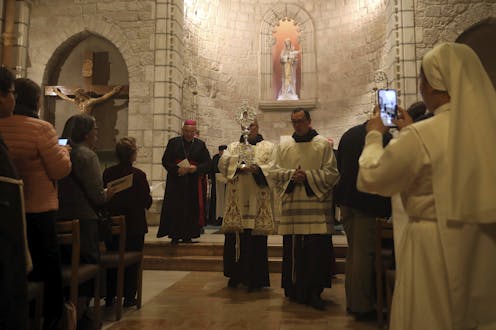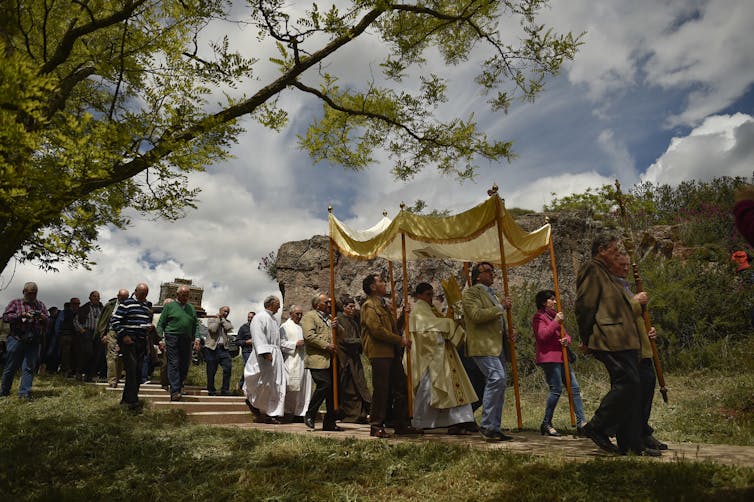What makes religious relics – like pieces of the 'true cross' and hair of saints – sacred to Christi
Relics often provided a way to bring more pilgrims into a church – and therefore, more offerings.

A Russian missile cruiser Moskva, the flagship of its Black Sea fleet, sunk after it was heavily damaged in April 2022. Kremlin officials said that a fire on board caused munitions to explode, while Ukrainian officials claimed they had attacked the Moskva. Several media reports noted that the ship might have been carrying a relic of the “true cross,” a piece of the actual wooden cross on which Christians believe that Jesus suffered and died.
The possibility of the relic being on the sunken ship cannot be ruled out. A collector is said to have donated the relic in 2020 to the Russian navy, which planned to place it in the Moskva’s onboard chapel. It is unclear, however, whether the relic was on board the ship in its chapel when the vessel went into combat. But the widespread interest in the possibility of this ancient relic being on board points to its importance for many Christians.
As an expert in medieval Christian liturgy and worship, I know that veneration of relics has a long history in Christian devotional practice.
Venerating martyrs
In the first three centuries of Christianity, Christians, whose religion was outlawed, prayed at the entombed bodies of martyrs, who were executed for refusing to renounce their new faith.
After the Roman Empire legalized Christianity in the early fourth century, smaller buildings called shrine churches were sometimes built around the tomb of a martyr. At times, the bodies of the martyr were exhumed by local bishops and reburied within the city itself, in a special tomb beneath the floor of a larger church or basilica.
Prior to this practice, bodies of the dead were kept in tombs and catacombs built outside of the city’s walls so as to separate them from the “city” of the living. But Christians believed in the power of the martyrs and, later, other saintly persons to intercede on their behalf with God. Saints were respected and their relics and images venerated, but they were not adored or worshipped as God might be.
Jesus’ cross
After Emperor Constantine legalized Christianity, Jerusalem became an important center for Christians who wanted to make religious trips to visit the places where Jesus and his apostles lived and preached. The term pilgrimage, meaning journey, originated at the time.
During this time, what was believed to be a piece of the “True Cross” was brought back to Europe – supposedly by St. Helena, the emperor’s mother – and broken up into smaller pieces.
Another section remained in Jerusalem and was venerated there, until in the early seventh century a Persian emperor, a Zoroastrian, conquered the city and removed the relic among the spoils of war. Several years later, the Persians were themselves conquered by the Christian emperor Heraclius, who returned the relic to Jerusalem. There it remained, even after the Muslim conquest of Jerusalem later that century.
Pilgrimage to see relics
As Christianity spread throughout Europe, beyond the boundaries of the Roman Empire, so did the practice of venerating the saints.
The demands for a saintly “body” increased, and so the remains of famous or local saints were divided into pieces, which included clippings of hair, or sometimes whole body parts. These “relics” – from a Latin word meaning “something left behind” – were frequently placed in special containers or display cases, called reliquaries.
These were usually especially elaborate, made of precious metals and adorned with jewels as a reflection of the special reverence for these elements that had touched the body of Jesus Christ.
The more famous the relic, the more pilgrims would make their way to the church or monastery where it was kept, and the more the clergy could earn through the offerings visitors made at the shrine.

By the turn of the millennium, the number of pilgrims traveling to visit Jerusalem from Europe increased, but tensions mounted between Muslim rulers and Christian leaders. There was friction among various Christian nobles and kings as well. Because of this, in the late 11th to the late 13th centuries, Christian political and religious leaders led a series of major wars – the Crusades – to regain control of the Holy Land from its Muslim ruler.
One result was an increase in the number of “relics” of Jesus, Mary and other New Testament figures brought back to Europe and circulated as authentic.
Some of these included fragments of bone or hair from apostles or other saintly figures, while others consisted of scraps of fabric from their clothing. Most esteemed of all were objects that supposedly had touched the body of Jesus himself, especially those connected with his suffering and death, such as the spikes used to nail him to the cross.
Power of relics
By the end of the medieval period, there was an overwhelming number of stories associating relics with miracles, such as unexpected healings or protection from the dangers of weather.
Many ordinary Christians treated the relics as a kind of lucky rabbit’s foot, owned or reverenced for personal protection. This was true for relics of the true cross as well. In Venice, for example, several miracle stories of the true cross, especially of it saving ships from storms, circulated widely.
During the Reformation of the 16th century, many European Protestant writers objected to the Catholic veneration of relics. Most felt that it was a practice not found in the Bible; others felt that many believers were worshipping saints as if they were divine, and that many devotional practices involving relics involved fraud and superstition, not genuine prayer. The Protestant theologian John Calvin suggested that if all of the supposed fragments of the “True Cross” were gathered together, they would fill an entire ship.
Even some Catholic scholars of the period, notably Erasmus of Rotterdam, criticized the fraudulent manipulation of believers for cash offerings when visiting shrines, and questioned the authenticity of many relics.
In 1563, the Catholic Council of Trent responded to all of these criticisms by clarifying the Catholic view of relics in an official decree. In the document, the assembled bishops stressed that devotional activities involving relics should not border on superstition in any way, that “filthy lucre” – buying and selling of relics – be “abolished” and that veneration ceremonies not devolve into “revellings and drunkenness.”
What makes a relic more precious
Until very recently, Catholic tradition divided relics into several classes, depending on their relationship to Christ or the saints. A first-class relic was a fragment of a saint’s actual body, like a tooth, hair clipping, or sliver of bone.
Pieces of objects involved in the Passion of Christ were also included in this class, since traditional theology teaches that Jesus Christ rose again from the dead after three days in the tomb and ascended bodily into heaven 40 days after.
Whether prized as a lucky charm or venerated as a powerful reminder of the sacrificial death of Jesus Christ, this Russian relic of the true cross has taken its place in the paradoxical history of these valuable religious objects: The peaceful message of Jesus has often been lost in the violent chaos of war.
[Explore the intersection of faith, politics, arts and culture. Sign up for This Week in Religion.]
Joanne M. Pierce does not work for, consult, own shares in or receive funding from any company or organization that would benefit from this article, and has disclosed no relevant affiliations beyond their academic appointment.
Read These Next
Trump’s Greenland ambitions could wreck 20th-century alliances that helped build the modern world or
How the US treats its allies has been a crucial question for every president. What evolved over the…
An ultrathin coating for electronics looked like a miracle insulator − but a hidden leak fooled rese
A new study investigated the source of a leak in a ‘miracle measurement’ from 2010 – and engineers…
For 80 years, the president’s party has almost always lost House seats in midterm elections, a patte
As the 2026 midterm elections edge closer, most people know the party that controls the White House…






